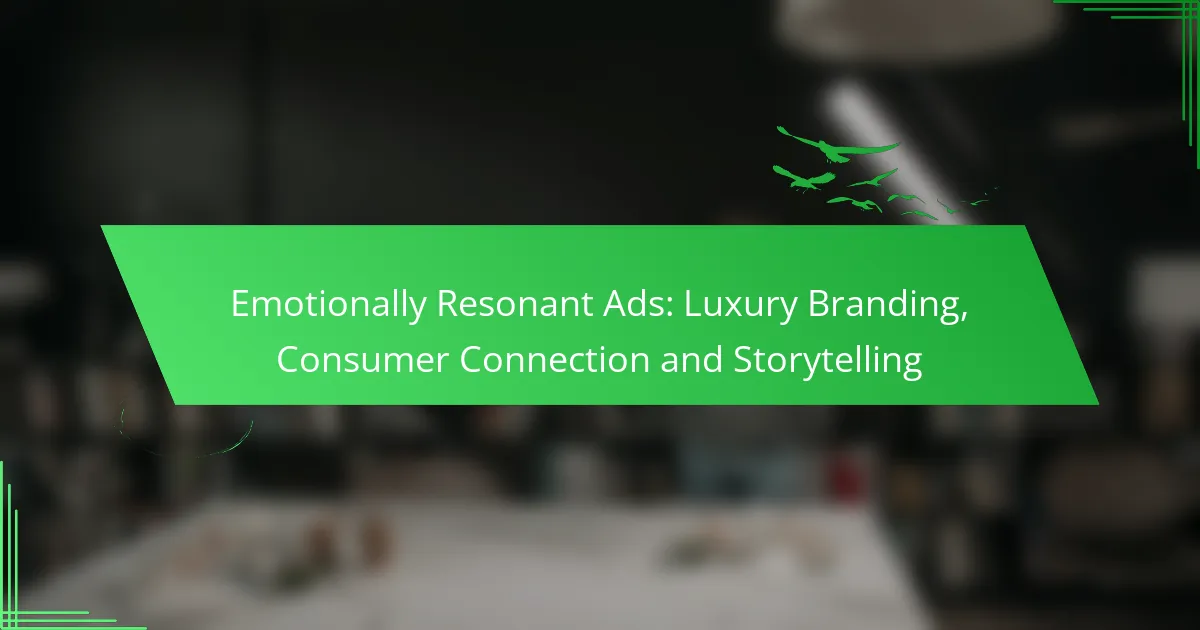Emotionally resonant advertising is essential for luxury brands seeking to establish a profound connection with consumers. By leveraging storytelling, cultural relevance, and personalized experiences, these brands can create narratives that align with the values and aspirations of their audience. This approach not only enhances brand loyalty but also transforms consumer interactions into meaningful relationships that extend beyond simple transactions.

How can luxury brands create emotionally resonant ads in Canada?
Luxury brands in Canada can create emotionally resonant ads by focusing on storytelling, cultural relevance, and deep consumer engagement. These elements help forge a strong connection between the brand and its audience, enhancing brand loyalty and perception.
Utilizing storytelling techniques
Storytelling is a powerful tool for luxury brands, as it allows them to convey their values and heritage in a relatable manner. By crafting narratives that resonate with consumers’ aspirations, brands can evoke emotions that lead to stronger connections.
For instance, a luxury watch brand might share a story about craftsmanship passed down through generations, highlighting the artisans behind the product. This not only showcases quality but also creates a sense of authenticity and tradition.
Incorporating cultural elements
Incorporating cultural elements into advertising can significantly enhance emotional resonance. Canadian luxury brands should consider local customs, values, and symbols that reflect the diverse identities of their audience.
For example, a fashion brand might feature indigenous art or collaborate with local artists to create limited-edition pieces. This approach not only honors cultural heritage but also fosters a sense of community and belonging among consumers.
Engaging with consumer emotions
Engaging with consumer emotions is essential for luxury brands to create impactful ads. Brands should aim to evoke feelings such as joy, nostalgia, or aspiration through their messaging and visuals.
Using imagery that reflects aspirational lifestyles or moments of personal achievement can resonate deeply. For instance, a luxury car advertisement might depict a family enjoying a scenic drive, tapping into feelings of freedom and togetherness.

What are the key elements of effective storytelling in luxury advertising?
Effective storytelling in luxury advertising hinges on creating a narrative that resonates emotionally with consumers, fostering a deep connection to the brand. Key elements include character development, conflict and resolution, and emotional appeal, each contributing to a compelling and memorable brand experience.
Character development
Character development in luxury advertising involves crafting relatable and aspirational figures that embody the brand’s values. These characters often reflect the target audience’s desires and lifestyles, making them more engaging. For instance, a luxury watch ad might feature a successful entrepreneur whose achievements resonate with viewers, enhancing the brand’s prestige.
To effectively develop characters, brands should consider their audience’s demographics and psychographics. This understanding helps in creating characters that not only attract attention but also foster loyalty and connection.
Conflict and resolution
Conflict and resolution are crucial in storytelling, as they create tension that keeps the audience engaged. In luxury advertising, the conflict often revolves around personal aspirations or societal challenges that the brand can help resolve. For example, a luxury car ad might depict the struggle of balancing work and family life, with the car symbolizing freedom and success.
Brands should ensure that the resolution feels authentic and aligns with their core message. A well-crafted resolution can reinforce the brand’s image and encourage consumers to envision themselves overcoming similar challenges with the help of the product.
Emotional appeal
Emotional appeal is at the heart of effective storytelling in luxury advertising, as it taps into the audience’s feelings and desires. Luxury brands often evoke emotions like joy, nostalgia, or aspiration, making the product more than just a purchase but a part of a lifestyle. For instance, an ad showcasing a family gathering around a luxury dining set can evoke warmth and connection.
To maximize emotional impact, brands should use visuals, music, and narratives that resonate with their audience’s values and experiences. This approach not only enhances brand recall but also fosters a deeper emotional bond, encouraging consumers to choose the brand over competitors.

How do luxury brands connect with consumers on an emotional level?
Luxury brands connect with consumers emotionally by crafting narratives that resonate with their values and aspirations. Through storytelling, personalized experiences, and a focus on exclusivity, these brands foster deep connections that go beyond mere transactions.
Personalized marketing strategies
Personalized marketing strategies are essential for luxury brands to engage consumers on an emotional level. By utilizing data analytics, brands can tailor their messaging and offers to individual preferences, creating a sense of exclusivity. For example, a luxury fashion brand might send personalized invitations to private events based on past purchases.
Additionally, leveraging customer relationship management (CRM) systems allows brands to track interactions and preferences, enhancing the personalization of future communications. This approach not only increases engagement but also strengthens the emotional bond between the brand and the consumer.
Building brand loyalty
Building brand loyalty in the luxury sector involves creating a sense of belonging among consumers. Brands can achieve this by consistently delivering exceptional quality and service, which reinforces the emotional connection. Loyalty programs that offer exclusive rewards, such as early access to new collections or personalized gifts, can further deepen this relationship.
Moreover, storytelling plays a crucial role in fostering loyalty. By sharing the brand’s heritage and values, luxury brands can resonate with consumers who identify with those narratives, leading to long-term loyalty and advocacy.
Creating immersive experiences
Creating immersive experiences is a powerful way for luxury brands to connect emotionally with consumers. This can include interactive events, exclusive product launches, or personalized shopping experiences that engage multiple senses. For instance, a luxury car brand might offer test drives in scenic locations, allowing potential buyers to experience the brand’s lifestyle firsthand.
Additionally, digital experiences, such as virtual reality showrooms or augmented reality apps, can enhance consumer engagement by providing unique ways to interact with products. These immersive experiences not only captivate consumers but also create lasting memories that strengthen their emotional ties to the brand.

What role does visual aesthetics play in luxury branding?
Visual aesthetics are crucial in luxury branding as they create an immediate emotional connection with consumers. High-quality visuals convey exclusivity and sophistication, influencing perceptions of value and desirability.
High-quality imagery
High-quality imagery is essential in luxury branding as it showcases products in the best light. Crisp, detailed images can evoke feelings of aspiration and indulgence, making consumers more likely to engage with the brand.
Investing in professional photography can significantly enhance a brand’s image. For example, using lifestyle shots that depict products in elegant settings can create a narrative that resonates with the target audience.
Consistent brand identity
A consistent brand identity reinforces recognition and trust among consumers. Luxury brands should maintain uniformity in visual elements such as logos, typography, and imagery across all platforms.
This consistency helps to establish a strong brand presence. For instance, using a specific color palette and style in advertisements and social media can create a cohesive look that consumers associate with luxury.
Use of color psychology
Color psychology plays a significant role in luxury branding by influencing consumer emotions and perceptions. Different colors evoke specific feelings; for example, gold often represents luxury and prestige, while black conveys sophistication.
Brands should carefully select colors that align with their identity and target market. A well-thought-out color scheme can enhance brand recognition and appeal, making it essential to test color combinations that resonate with the desired audience.

How can data analytics enhance emotional resonance in advertising?
Data analytics can significantly enhance emotional resonance in advertising by providing insights into consumer preferences and behaviors. By analyzing data, brands can tailor their messaging and storytelling to connect more deeply with their target audience, fostering stronger emotional ties.
Consumer behavior insights
Understanding consumer behavior is crucial for creating emotionally resonant ads. Data analytics can reveal patterns in purchasing habits, preferences, and emotional triggers, allowing brands to craft messages that resonate on a personal level. For instance, analyzing social media interactions can help identify which themes or narratives evoke strong emotional responses from consumers.
Brands can utilize tools like sentiment analysis to gauge public perception and emotional reactions to their campaigns. This insight enables them to refine their storytelling approach, ensuring it aligns with consumer values and aspirations.
Targeted ad placements
Targeted ad placements leverage data analytics to position ads where they are most likely to resonate emotionally with the intended audience. By analyzing demographic data, interests, and online behavior, brands can select platforms and formats that enhance engagement. For example, luxury brands might choose high-end lifestyle websites or social media influencers to reach affluent consumers effectively.
Moreover, utilizing retargeting strategies can remind potential customers of their previous interactions, reinforcing emotional connections. However, brands should be cautious not to overwhelm users with excessive ads, as this can lead to negative perceptions and diminish emotional resonance.
